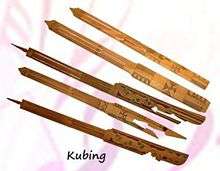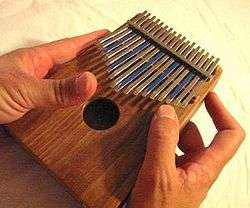Kubing
The kubing is a type of Philippine jaw harp from bamboo found among the Maguindanaon and other Muslim and non-Muslim tribes in the Philippines and Indonesia. It is also called kobing (Maranao), kolibau (Tingguian), aru-ding (Tagbanwa),[1] aroding (Palawan),[2] kulaing (Yakan), karombi (Toraja), yori (Kailinese) or Kulibaw. Ones made of sugar palm-leaf are called karinta (Munanese), ore-ore mbondu or ore Ngkale (Butonese).[3]

A variety of kubing harps

Playing the kubing
The kubing is traditionally considered an intimate instrument, usually used as communication between family or a loved one in close quarters. Both genders can use the instrument, the females more infrequently than males who use it for short distance courtship.[4]
See also
- Jaw harp
- Lamellophone
References
| Wikimedia Commons has media related to Kubing. |
- Hila, Antonio C (2006). "Indigenous Music - Tuklas Sining: Essays on the Philippine Arts". Filipino Heritage.com. Tatak Pilipino. Retrieved June 12, 2006.
- de Leon, Jr., Felipe M (2006). "Gawad sa Manlilikha ng Bayan - 1993 Awardee - MASINO INTARAY and the Basal and Kulilal Ensemble". National Commission For Culture and the Arts. 2002. National Commission For Culture and the Arts. Archived from the original on July 16, 2006. Retrieved June 12, 2006.
- Amin, Mohammad (2005). "A Comparison of Music of the Philippines and Sulawesi". Sulawesi Studies. Retrieved June 12, 2006.
- Mercurio, Philip Dominguez (2006). "Traditional Music of the Southern Philippines". PnoyAndTheCity: A center for Kulintang - A home for Pasikings. Retrieved June 12, 2006.
External links
- "Grinnell College Musical Instrument Collection: Kubing", Grinnell.edu.
This article is issued from Wikipedia. The text is licensed under Creative Commons - Attribution - Sharealike. Additional terms may apply for the media files.
